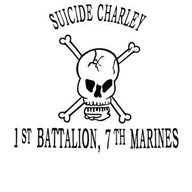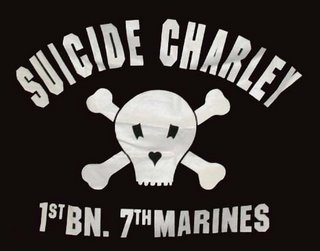On 24 October 1942, the 1st Marine Division occupied a defensive position around Henderson Field on Guadalcanal. The 1st Battalion, 7th Marines, commanded by LtCol Lewis B. “Chesty” Puller, helped form this line. “C” Company was flanked by “B” Company on the right and “A” Company on the left. At approximately 2200, the Japanese launched a major offensive, throwing three Regiments and part of a Brigade against the battle-weary, disease-ridden Marines. “C” Company received the brunt of the Japanese attack.
However, despite this horrific onslaught, the morning of 25 October found the defensive line of the 1st Marine Division still intact. The Japanese attack had been repelled. Later that morning, a flag appeared over the “C” Company position. It consisted of white Japanese parachute material with a skull and cross bones crudely painted on and inscribed with “1st Battalion 7th Marines Suicide Charley”. The flag continued to appear throughout the hard-fought battle for Guadalcanal.
The “Suicide Charley” banner was not seen again until the battle for Peleliu. During one particular phase of that bloody battle, a replica appeared briefly to inspire the tired Marines to victory.
Korea provided the stage for the next appearance of this battle symbol. While on “R&R” some members from “C” Company, 1st Battalion, 7th Marines, had a new “Suicide Charley” flag made and proudly carried it back to Korea, misspelled name and all. From that day on, the black and white “Suicide Charley” flag has traveled the world over with the Company. Many replicas have come and gone throughout the years, but the history of “Suicide Charley” has been passed to each generation of new Marines.
In 1961, the Commanding General of the 1st Marine Division authorized “C” Company, 1st Battalion, 7th Marines to display and carry the “Suicide Charley” guidon at all official ceremonies and functions. The tradition is proudly carried on today.


